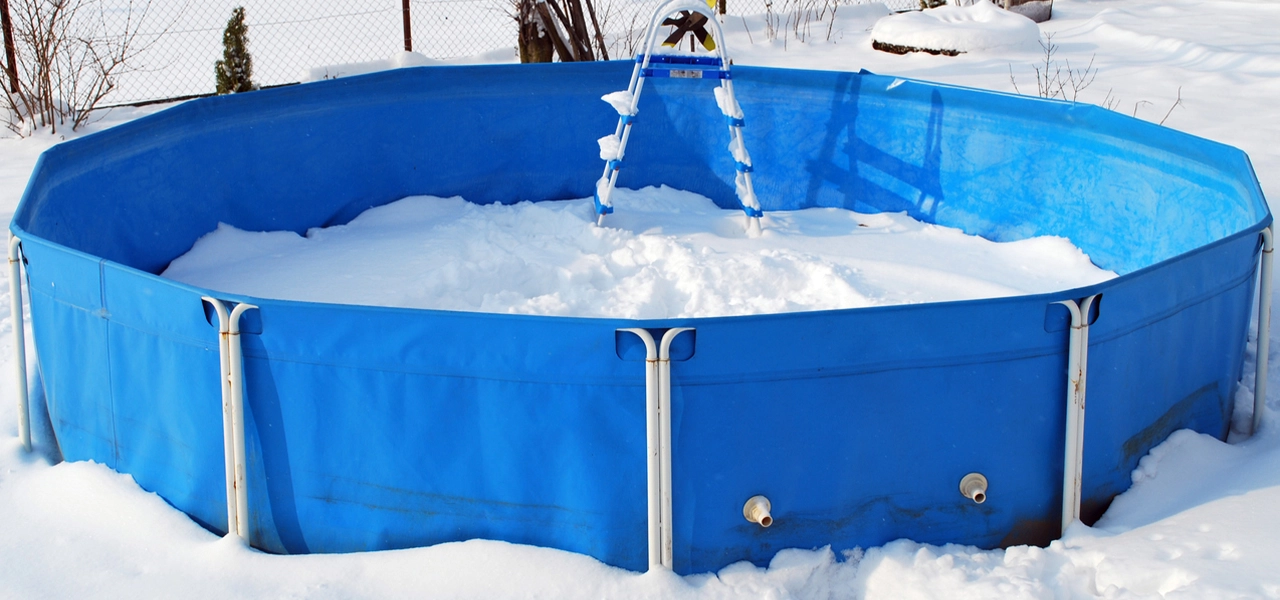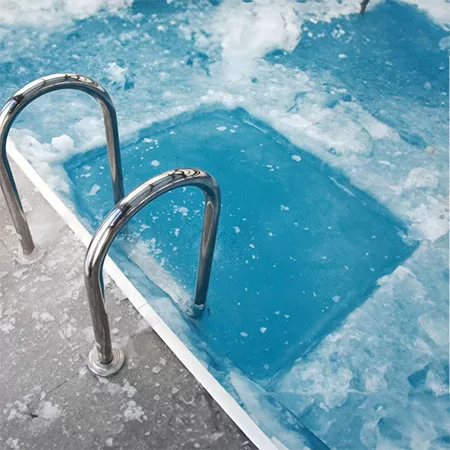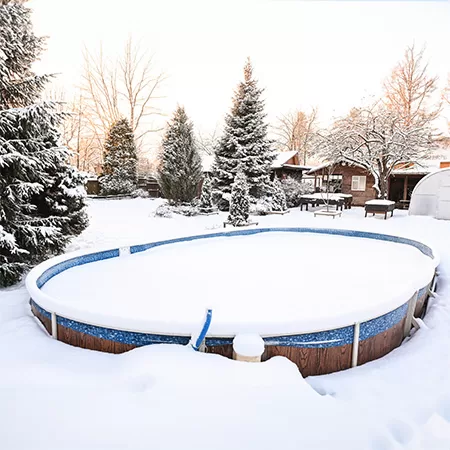FREE Standard Shipping On All Orders $100 or More!*

Ice Damage to an Above Ground Pool
Winter can be an extremely challenging time for pools and pool owners. From worrying about structural damage, to fixing broken pipes in freezing weather, there are many things that can go wrong in the off-season. And if you have an above ground pool, you know how difficult it can be to protect your beloved pool in winter. In this article, we discuss how to prevent and fix above ground pool ice damage.
Iceberg in Your Pool

Above ground pool walls are cold, like an ice cube tray, and the ice sheet grows very fast and thick. Inground pools have soil surrounding the walls, which gives both support and temperature regulation.
As water turns to ice, it expands 9%, putting pressure on the pool walls as it expands outward. Using an air pillow under a tight pool cover is crucial to prevent ice and pressure buildup.
In addition, the water level in your pool supports the floating sheet of ice, as it presses up against your pool walls and liner. If the pool develops a leak, the heavy ice sheet can scrape down the sides of the pool wall as it falls, shredding a pool liner.
Skimmer Wall Buckled:
When the water level in the pool drops even an inch, the ice sheet will also drop. If the ice is frozen into the inside of the skimmer, this can cause serious damage to the pool. Using a skimmer cover will keep thick ice from freezing into the inside of the skimmer, which can crumple the wall below the skimmer.
Alternatively, you can use a Gizzmo type skimmer guard. A skimmer guard works like an air pillow by absorbing ice expansion. But instead of protecting the pool walls, it protects your skimmer walls from the outward expansion of ice. Without a skimmer guard, a plugged skimmer can easily crack from freeze damage, requiring replacement.
Above Ground Wall Collapse:
If an above ground pool leaks while the winter pool cover is frozen solid into the ice sheet, either the cover will rip, or the pool walls will collapse inward. This is why air pillows are so vital for above ground pools. When used properly, they will prevent ice from freezing solid under the pool cover. You will need enough air pillows to cover about 10% of the pool surface area. The unfrozen area under the air pillows allows the ice to expand slightly inward, instead of expanding outward against the walls.
Pool Cover Ice Damage:
But what about a giant ice sheet on top of the pool cover? Usually the pool cover will fail first, unless the pool has serious structural damage and weak supports. A heavy ice sheet on the cover can also develop sharp edges as it thaws, which can cut the pool cover. This is why using a cover pump is so important for above ground pools. Cover pumps prevent rain and snow melt from building up on the cover, which can damage the cover and pool. 1–2 inches of water is not concerning, but an excessive amount of water can eventually freeze on top of the cover.
Use your cover pump regularly to keep the pool cover drained, or even better an automatic pool cover pump, so you don't have to think about it during winter. We have several automatic cover pumps, the 350 GPH Ocean Blue, the 1200 GPH Water Wizard, and the 1800 GPH AquaPro cover pump, all feature automatic shut-offs when the cover pumping is complete.
Snow Damage to Above Ground Pools

A foot of snow covering the entire surface of a 24' round pool can weigh over 9,000 pounds. Walls may bend or bow at the weakest point, or uprights can buckle. But the biggest worry may not be wall problems, but pool liner ice damage. The weight of snow and ice on top of the remaining water in the pool increases the pressure, and can cause tiny weepers in a pool liner to open up into full-on leakers.
Now we have real problems, because when the water leaks out, it no longer supports the ice sheet above it. When the ice sheet falls suddenly, it can rip the liner or damage the pool wall.
Pool ice sheet slips and falls: Even when the water runs out beneath the block of ice, a pool ice sheet can be stuck hard to the edges around the pool, and become suspended above the water, wall to wall, with open space between the ice and the pool water. Then the ice begins to melt. Shrinking around the edges first, the ice sheet slips, and falls to the water level.
However, it won't usually fall straight down to the water. Large sheets of ice on a pool often fall unevenly, at jagged angles to the pool wall and pool liner.
A 6" sheet of ice on a 24' round pool can weigh over 6 tons, and with sharp icy edges that can rip a pool liner, you can understand why this may be your largest winter worry about your above ground pool - leaking water in a pool with a large ice sheet on the surface.
Leaking Winter Pools
Water leaks are not only a nuisance in the swimming season, but they actually are much more mischievous and detrimental in the winter months. Without the water level in the pool to support the ice sheet above it, a leaking pool can be damaged from the ice sheet when it falls or shifts. Under the cover, ice will form because of freezing pool water. Ice will also form on top of the cover from snow and ice accumulation. If the pool water beneath the ice sheet was to drain out, the support for the ice is gone. In both situations, the ice will settle where gravity takes it and the only thing standing in its way is your pool walls and pool liner.
A leaking pool can also cause extensive damage to the above ground pool's frame. While the pool is covered, if you notice the cover sinking into the pool (from a leak in the vinyl liner) and/or there is visual stress where the cover meets the top rail, we suggest releasing the cover into the pool. This will relieve the stress and tension on the cover that can cause a collapse. If you are able to detect even a slight leak during the swimming season, take every step possible to fix any leak before closing the pool.
Ice & Snow Repairs to Above Ground Pools
Wall damage may seem irreparable, and in some cases it is - but in other cases, there are methods for repairing an above ground pool damaged by snow and ice.
Since most above ground pool walls come in a continuous roll of sheet metal, you can't usually just order a new panel, unless the damaged area is a separate stainless steel panel used for the skimmer and return, which is not very common.
Straightening Pool Walls:
You can usually straighten out most bent and buckled steel walls and uprights. All you need is lumber and a large hammer or maul. Lower the water in the pool to a point below the damage, and pull the liner away from the wall. Have a helper hold a large kicker - heavy 6x6 lumber nailed into a triangle shape, on the inside of the pool, while you hammer on the outside. Heavy blows will flatten the wall, remove the creases, and restore the wall to full height.
In cases where the pool wall is bent, bowed or buckled, you can use full wall height sheet metal pieces, 'glued and screwed' in place, on the inside of the wall. Duct tape the wall repair sheet edges and cover with Wall Foam, before reinstalling the pool liner.
Pool Wall Repair Panels:
The best sheet metal pieces for wall repair are called 'Flats', don't bother with the 12" wide roll sheet metal, it's not very strong. Find a 48" tall flat sheet of Galvanized Steel with thickness of 20-30 Gauge. Securing a full height piece is more work, but will add strength to the area, and give you better odds for a successful pool wall repair. Find these online, or at your local metal supply company.
Fixing Buckled Pool Walls:
On crumpled or bent pool walls, first bang out the bumps with the method described above, to restore the wall to full height *important*.
Skimmer holes and return holes can be drilled and cut out if needed. Secure with Liquid Nails, followed by small rivets or screws every 3" on both sides, and then duct tape the edges. Finish with a layer of Wall Foam over the area, or around the entire pool wall.
Preventing Ice & Snow Damage
- Always use an Air Pillow under winter pool covers.
- If the pool leaks during winter, release the pool cover.
- Remove snow buildup on top of the pool - carefully.
- Use skimmer closures like Skimmer Plug, to protect your skimmer, and wall.
- Use a good pool cover pump to keep the ice sheet thin.
This winter has been tough on above ground pools, I hope this post answered your questions about your particular situation.